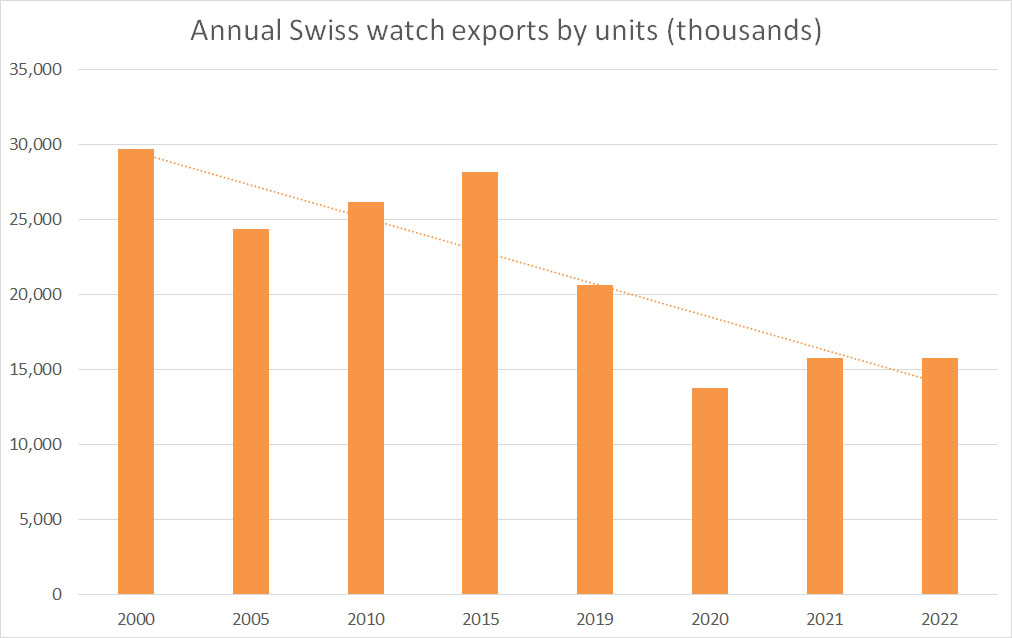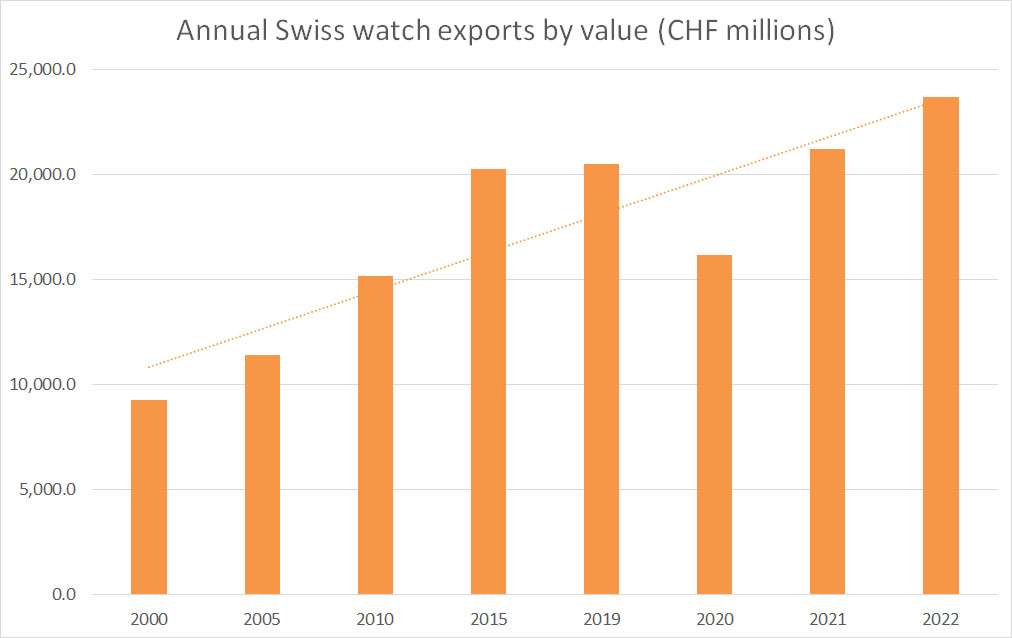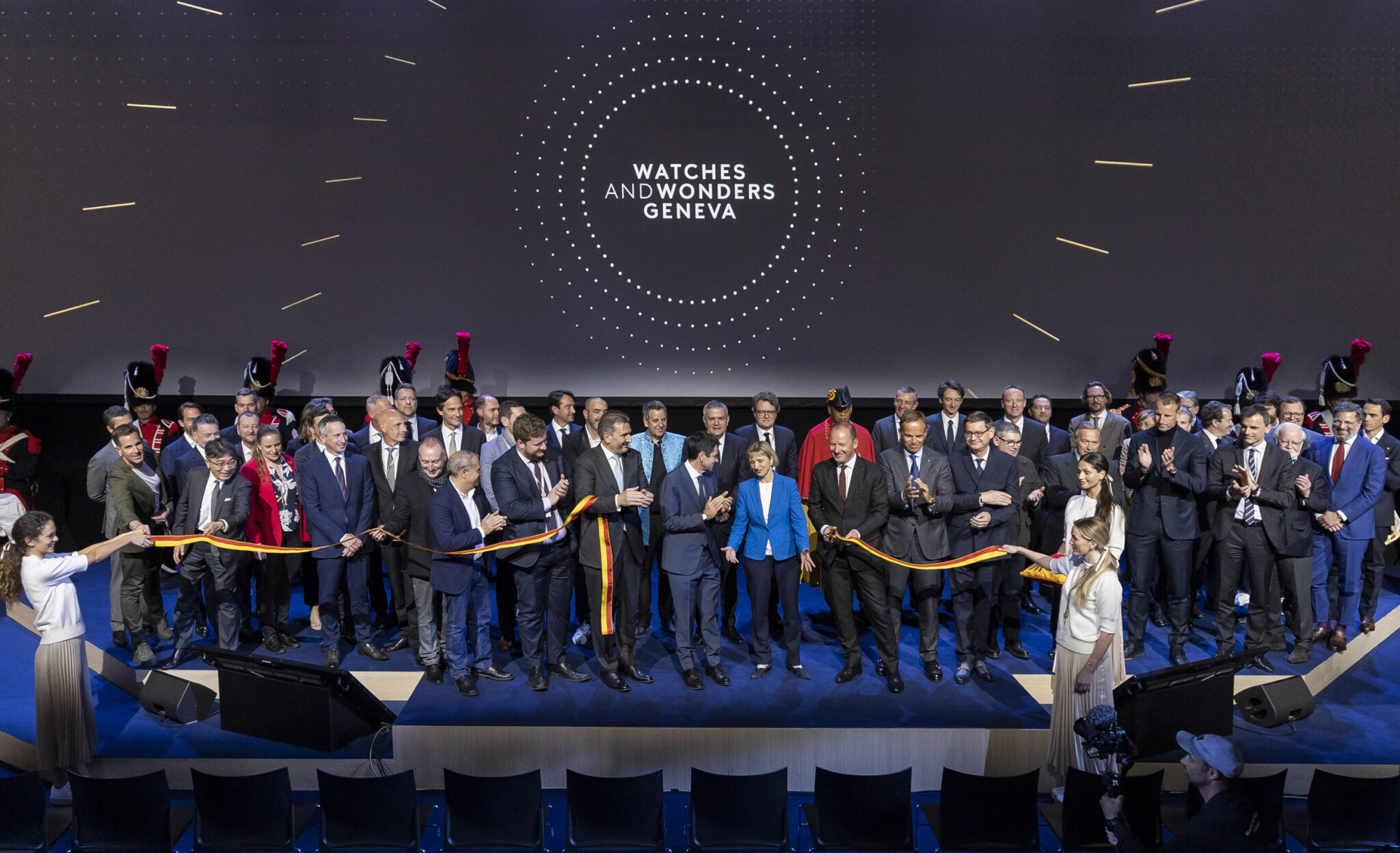Swiss watch export values hit a record high last year, but Robin Swithinbank wonders whether the industry is really growing?
When the FHS announced last year’s Swiss watch export results a couple of months ago, the prevailing sense was that 2022 had been a very good year for the industry.
The independent federation’s report said the world had bought a record CHF24.8 billion worth of Swiss watches (at export prices – roughly half retail) last year, an increase of 11.4 per cent on the pervious 12 months. This was welcomed by the FHS, who described it as “an excellent year”.
But was it? Alongside values, the FHS also reports volumes. In 2022, and despite significantly improved conditions for distribution compared to 2021, volumes were up by a far less impressive 0.3 per cent, a margin that confirms a trend that began long before the pandemic: by volume, the Swiss watch industry is in rapid decline.
If that seems a stretch, let’s first crunch some numbers. In 2019, the pre-Covid baseline, export volumes reached 20.6 million. Last year, that record year by value, the figure had plummeted to 15.8 million.


The optics get worse when you go further back. In 2015, volumes were at 28.1 million, meaning that in seven years, the watch industry shelled more than 12 million units, a drop of almost 45 per cent. Excellent? Not by that measure.
This leaves us with a paradox. The Swiss watch industry is growing and shrinking at the same time.
How you appraise this will depend on how optimistic you are. Making more money: good. Fewer people buying your product: less good?
It would be easy at this point to single out the macro-economic factors at play here (the rise of wearables, unrest in Hong Kong, lockdowns in China and so on), but if there’s one thing we can be pretty sure of, it’s that the Swiss don’t much care for what everyone else is doing or thinking.
By which I mean that the lower volumes, higher prices trend isn’t reactionist, it’s protectionist. It’s Switzerland choice to produce less and make more. Smart, you’d think.
But let’s not give the Swiss too much credit. Looked at through the lens of history, Swiss watchmaking is still going through a process of redefinition that began 50 years ago and that was prompted by events beyond its control.
In the early 1970s and before the Quartz Crisis bit, Swiss watches were by and large for the masses. Accessible, we’d probably say now.
In 1974, exports peaked at an all-time high of 84.4 million watches and movements, but only a decade later, that figure had crashed to just 31.3 million, decimating the industry. At that point, Swiss watchmaking bifurcated into the everyday (Swatch) and the luxury. It had to, just to survive.
Over the past four decades, the industry’s luxury metamorphosis has continued. Everyday Swiss watches for the masses have declined in importance and the focus has shifted closer and closer to the high-end. This century alone, export volumes have halved, while values have more than doubled. Reading the FHS’s latest figures, we could conclude that the process appears almost complete.
Breaking those volume figures down makes the point clearer. The heaviest blow to exports has been to watches priced (at export) under CHF500. Almost all 12 million of the missing watches could be accounted for below this price point, although thanks to one million MoonSwatches, watches priced beneath CHF200 increased by 5.9 per cent last year. Hope for the masses, yet? Unlikely.
Meanwhile, the value gains are at the top, where volumes have increased by more than 25 per cent since 2015. Watches priced over CHF3,000 at export surged by 15.6 per cent in value last year, making the category worth almost CHF18 billion to the industry, three quarters of the total. The total luxurification of the Swiss watch industry is nearing completion.
And so now, with low-end Swiss watches all but irrelevant to the industry, what next? Give it another 10 years, and bar the odd MoonSwatch, what will be left in that ‘accessible’ space?
The trend looks set to continue. Of luxury’s three defining characteristics, rarity, exclusivity and cost, only cost remains. The digital age has democratised Swiss watchmaking and thanks to the success of businesses such as Hodinkee and Philips, anyone can become a collector of watch knowledge, if not the watches themselves. Cost is the only remaining defence luxury has against slipping into mainstream.
Is this a problem? Short-term, it’s hard to worry. Business is booming. LVMH, Richemont and Swatch Group have all reported growth, some of it spectacular. Hermes, whose watches are now outperforming its perfume and beauty division, is making so much money that it could afford to hand out €4,000 bonuses to each of its 19,700 employees in February, nearly €80 million in total. And no doubt when Morgan Stanley’s influential annual report is issued this spring, it will point to record numbers across the board.
But at the same time, something about this feels precarious. This is an industry that would have exported 84 million more units if volumes had remained consistent between 2015 and 2022. Isn’t that 84 million missed sales? Or even 84 million missed new recruits?
 Maybe it’s not so bad; you can argue it the other way round, too. We want what we can’t have, so by reducing output the Swiss are only making us want their watches more. And the rise of pre-owned could yet plug the gap, particularly if CPO revenues come to match those in the primary market, as some expect.
Maybe it’s not so bad; you can argue it the other way round, too. We want what we can’t have, so by reducing output the Swiss are only making us want their watches more. And the rise of pre-owned could yet plug the gap, particularly if CPO revenues come to match those in the primary market, as some expect.
Any consumer product industry needs a gateway. Aspiration starts with wanting something we don’t have and only levels up once we have it. There would be no private jets if there weren’t also passenger airliners. No Michelin stars without McDonalds. Beauty only emerges alongside the ordinary.
For now, the industry can breathe easy, but it owes a debt of thanks to wearables and the Apple Watch in particular. Since it was launched in 2015, a sliding doors year for the industry, it has created an aspiration springboard.
But does that mean the Swiss watch industry is growing? I’m not sure it does.


I’d worry they are starting to price people out. I bought a Reverso duo face in Feb 2022 new for £7200 and 1 year in later it’s £11,400 a 58% increase in a year. I wouldn’t even consider buying one now at that price and according to the government stats I’m in the 97th percentile for earnings in the UK. I’ve gone from buying a couple of of watches a year to now not buying any as I can’t justify having a single item on my person worth so much
I’m with David (above) on this. The time was when you could buy a nice watch for the same kind of money as a really good DSLR camera and lens – and I did: an Omega here, an IWC there. Nothing ostentatious, just nice pieces, but now I simply can’t justify the kind of money that these, and other, brands are asking. I’m finding much pleasure and enjoyment in watches far lower down in the pecking order: Seiko, Citizen, Casio, Orient, and even some very decently made Chinese watches. I admire some of the Swiss output today, but my watch buying cash is going elsewhere.